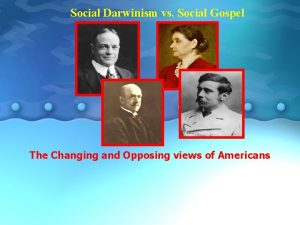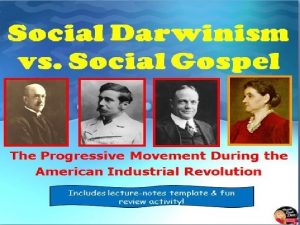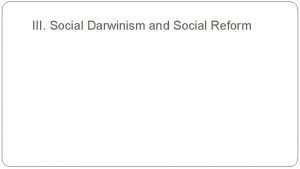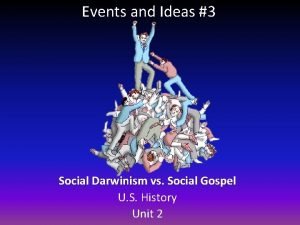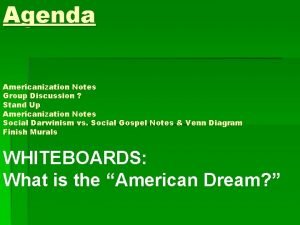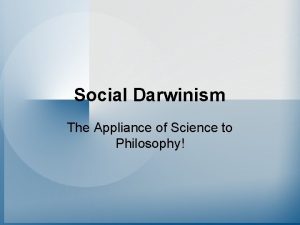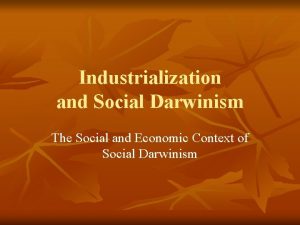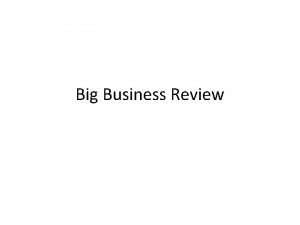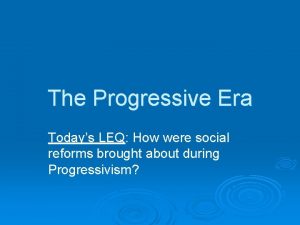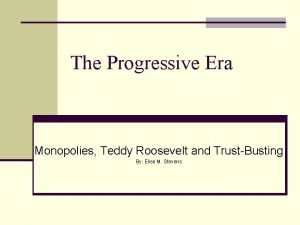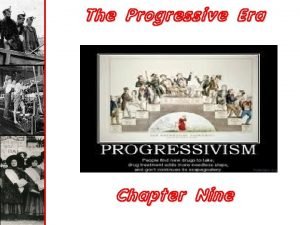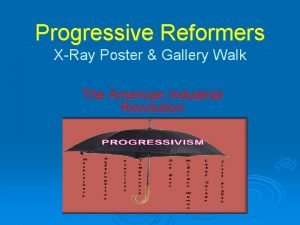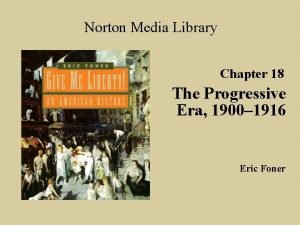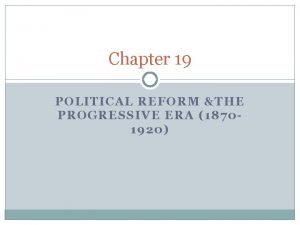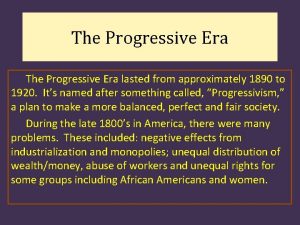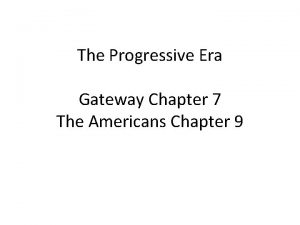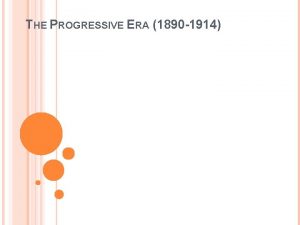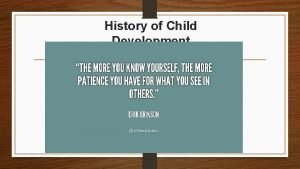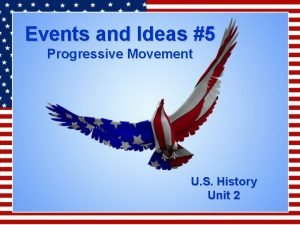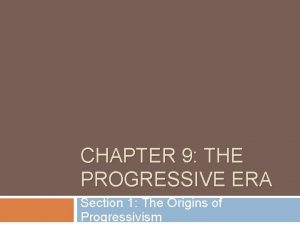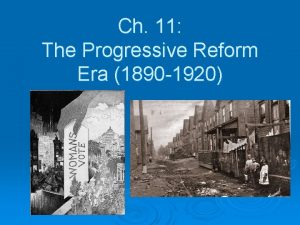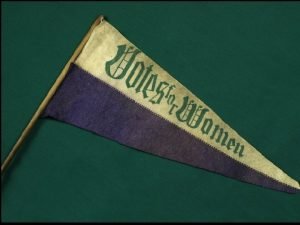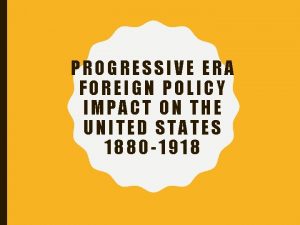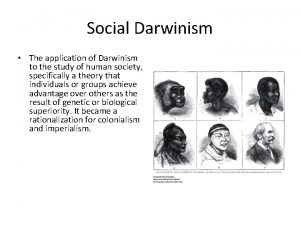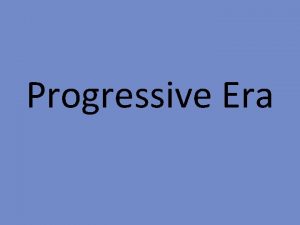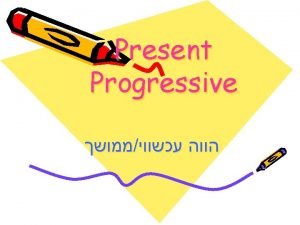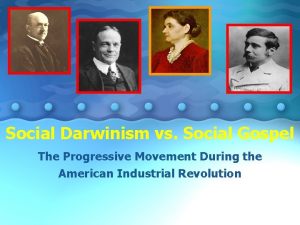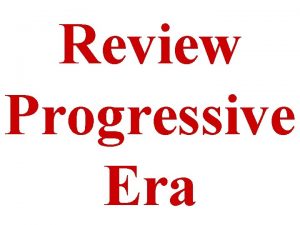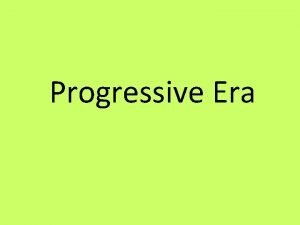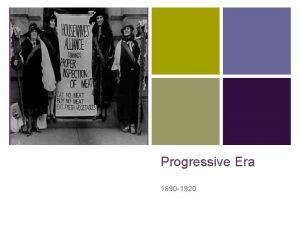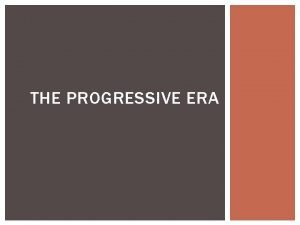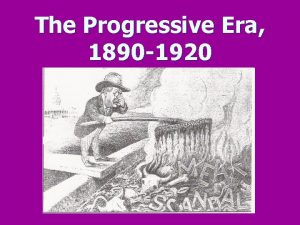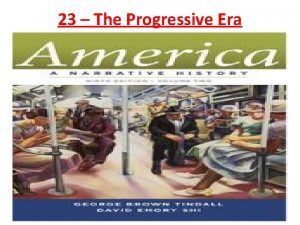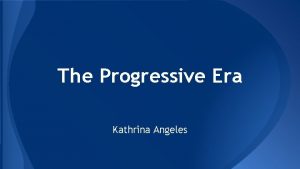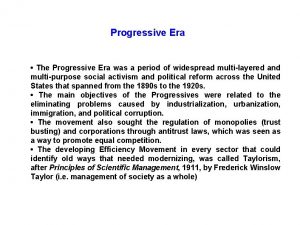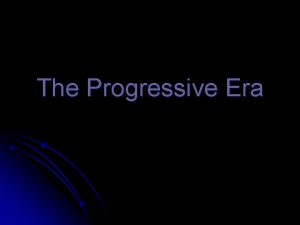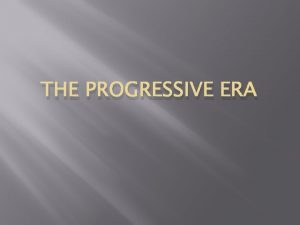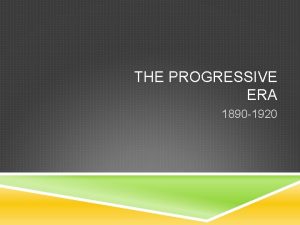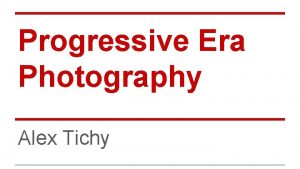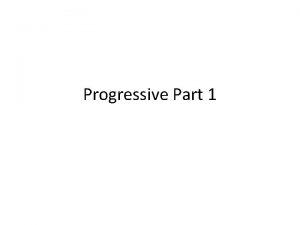THE PROGRESSIVE ERA SOCIAL THEORY Social Darwinism Application































- Slides: 31

THE PROGRESSIVE ERA

SOCIAL THEORY

Social Darwinism • Application of survival of the fittest to society • Laissez-faire attitude • “Gospel of Wealth” William Graham Sumner

Jacob Riis • How the Other Half Lives (1890) • Reform could help the poor because their condition was the result of their environment not their nature

Socialism • Henry George Progress and Poverty (1879) • Questions why poverty persists as society progresses • Redistribution of wealth •

Social Gospel Movement • Protestant reform movement • “What has the Christian moralist to say about this state of things? He is bound to say that it is a bad state of things, and must somehow be reformed. . Christianity. . . ought with all its emphasis to say to society: "Your present industrial system, which fosters enormous inequalities, which permits a few to heap up most of the gains of this advancing civilization, and leaves the many without any substantial share in them, is an inadequate and inequitable system, and needs important changes to make it the instrument of righteousness. " This is not saying that Christians should ask the state to take the property of the rich and distribute it among the poor. . There are, however, one or two things, that he will insist upon as the immediate duty of the state. Certain outrageous monopolies exist that the state is bound to crush. . Another gigantic public evil that the state must exterminate is that of gambling in stocks and produce. ” Washington Gladden

INTRO TO PROGRESSIVISM

Progressivism • “Progressives wanted to apply the techniques of systematization, rationalization, and bureaucratic administrative control developed by business to problems posed by the city and industry. ” • Begins around 1890 with muckrakers and grassroots organizations led by women and liberal Protestants • Very diverse in goals • Goals • Social - issues of morality and civil rights • Political - political corruption and lack of democracy • Economic - monopolies and labor problems • Reforms start at local (municipal) and state level • Federal reform begins with Teddy Roosevelt in 1901

Teddy Roosevelt - The First Progressive President • TR’ has an unconventional rise to power and a unique view of the economy • New View of the Presidency • Prior deferral to Congress • New constitutional vision of expanded role • Roosevelt sees the presidency as the “Bully Pulpit”

Roosevelt’s “Square Deal” • “good trusts” vs. “bad trusts” • Three C’s • Consumer protection • Conservation • Corporate regulation

Election of 1912 • Taft – Republican Party • Debs – Socialist Party • Wilson – Democratic Party • New Freedom from corporate corruption and increased competition- no tariffs, graduated income tax • Temporary gov control in order to break up trusts • Support small business • • T. Roosevelt – Bull Moose Party • New Nationalism Control and heavily regulate big business • Higher taxes, labor and health laws, various insurance laws • Women’s suffrage •


GOVERNMENT REFORM

“Good Government” • Goals: "efficiency" and "expertise“ • municipal ownership of utilities • Expanded democracy • • Accomplishments: • Local/state City planners and city managers • Many cities established municipal waterworks, gasworks, and electricity and public transportation systems • Recall, initiative, and referendum • Direct primaries • • Federal 17 Amendment (1913): Direct election of Senators • 19 th Amendment (1919): Women’s Suffrage •

LABOR REFORM

Unionization • Major Unions: Knights of Labor - skilled and unskilled, black, white, and immigrant • American Federation of Labor - moderate and limited to skilled native born workers • Industrial Workers of the World - radical socialists and open to immigrants • • Accomplishments: Adamson Act (1916) - federal 8 hour work day (done at state level too) • Clayton Anti-Trust Act (1914) - Legalized peaceful strikes and exempted unions from anti-trust lawsuits • The Workingmen's Compensation Act (1916) - provided financial assistance to federal employees injured on the job • • Workman’s compensation in 32 states as well

Triangle Shirtwaist Fire and Labor Reform • 1909 20, 000 female garment workers go on strike led by Clara Lemlich and the International Ladies' Garment Workers' Union • The owners break the strike through violence and by having strikers arrested • 1911 – 146 Workers die in NY Garment factory fire trapped by flames, a collapsed fire escape and a locked door • Highlighted many of the issues that defined urban life in turn-of-the-century America labor unions, immigration, industrialization, and factory girls working in sweatshop conditions

Child Labor and Sweatshop Labor • Goals: End to child labor and special regulations to protect women in the workplace • National Consumers League boycotts unfair businesses • Accomplishments: • Local/state laws limiting work hours for women and children in 32 states • minimum wages for women workers in 11 states • • Federal Keating-Owens Act outlaws child labor (1916) • Muller v. Oregon (1908) •

IMMIGRATION

Settlement Houses • Goal: provide educational, recreational, and other social services to poor urban communities • Assimilate and “Americanize” immigrant women and children • • Accomplishments Settlement houses built in most major cities • Facilitated the growth of urban playgrounds • Created Pre-K and kindergarten programs in urban communities •

HEALTH AND FOOD REFORM

Regulation of Food and Drugs • Goals: safe food, water, and medicine • Upton Sinclair and The Jungle • Accomplishments: • Local/state public health officers launched successful campaigns against hookworm, malaria, TB, typhoid, and diphtheria. • Pure milk campaigns slashed rates of infant and child mortality. • water standards, state and local departments of health, sanitary codes for schools • • Federal Meat Inspection Act (1906) • Pure Food and Drug Act (1906) •

ENVIRONMENTALISM

Preservation • Goal: leave the wilderness untamed • Leaders: • John Muir • Accomplishments: • Creation of many preservationist societies and organizations like the Sierra Club and Boy Scouts of America

Conservation • Goals: • Ensure future generations have access to the nation’s resources by using them responsibly • Leaders: • Gifford Pinchot and Teddy Roosevelt • Accomplishments: • Regulate land resources through federal permits • Newlands Act 1902 and 1906 American Antiquities Act - enabled a president to protect wild lands as national monuments • 230 million acres of land protected • Created National Park Service

ECONOMIC REFORM

Trustbusting and RR Regulation • Prior obstacles • Selective enforcement of Sherman anti-trust act • ICC reluctant to regulate • Between 1897 and 1904, a total of 4, 227 firms merged to form 257 corporations

Economic Regulation • Accomplishments: • • • TR brought 44 anti-trust suits, prosecuting railroad, beef, oil, and tobacco trusts. Northern Securities v. United States – 1906 Standard Oil broken into 34 companies Elkins Act (1903) and Hepburn Act (1906) 16 th Amendment (1913) created income tax (Passed initially under Taft) Graduated • Initially affected. 5% of American families • • The Federal Reserve Act (1913)

MORALITY

Temperance • Goals: Prohibition • Important Groups: Anti-Saloon League • Frances Willard and the Women’s Christian Temperance Union • • Accomplishments • Local/state • • Blue laws Federal • 18 th Amendment (1919) banned the manufacture and sale of alcoholic beverages

Sexuality • Goal: “social purity” • Accomplishments: The New York Society for the Suppression of Vice and Comstock laws make “obscenity” illegal at state and federal level • Margaret Sanger unites women of all social classes and backgrounds behind the birth control movement • Concern for vulnerable women • Eugenics • Convicted for both writing an article about birth control for a magazine and opening a birth control clinic • Founded the first birth control clinic in America and funded research for the birth control pill •
 Social darwinism vs social gospel
Social darwinism vs social gospel Social darwinism vs. social gospel
Social darwinism vs. social gospel What was reform darwinism?
What was reform darwinism? Compare and contrast social darwinism and social gospel
Compare and contrast social darwinism and social gospel Social darwinism and social gospel venn diagram
Social darwinism and social gospel venn diagram Herbert spencer social darwinism
Herbert spencer social darwinism Industrial revolution and social darwinism
Industrial revolution and social darwinism Social darwinism definition
Social darwinism definition Darwinism
Darwinism Darwinism
Darwinism Explain the pseudoscientific ideas of social darwinism
Explain the pseudoscientific ideas of social darwinism Industrialists of the late 1800s used pools and trusts to
Industrialists of the late 1800s used pools and trusts to Present progressive passive or past progressive passive
Present progressive passive or past progressive passive Simple past and progressive
Simple past and progressive Present perfect tense function
Present perfect tense function Progressive era leq
Progressive era leq What was ida tarbell trying to change
What was ida tarbell trying to change Trust busting progressive era
Trust busting progressive era Progressive era dbq answers
Progressive era dbq answers Progressive era posters
Progressive era posters Chapter 18 the progressive era
Chapter 18 the progressive era Chapter 19 political reform and the progressive era
Chapter 19 political reform and the progressive era Initiative progressive era definition
Initiative progressive era definition The progressive era lasted from
The progressive era lasted from Gateway to us history chapter 7 the progressive era
Gateway to us history chapter 7 the progressive era Promoting moral improvement
Promoting moral improvement John dewey progressive era
John dewey progressive era Progressive era worksheets
Progressive era worksheets Chapter 9 the progressive era section 1 answers
Chapter 9 the progressive era section 1 answers Chapter 11 the progressive reform era
Chapter 11 the progressive reform era Progressive era
Progressive era Dollar diplomacy pros
Dollar diplomacy pros
